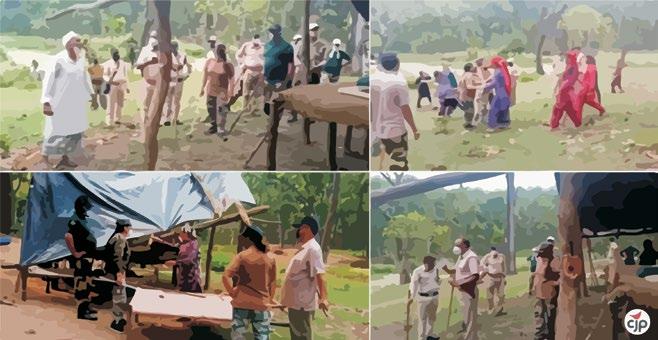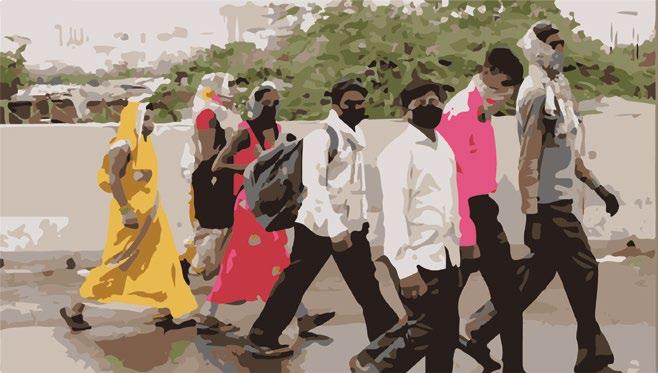
7 minute read
Adivasis
Image: cjp.org.in
India’s Indigenous people and the struggle for Forest Rights
The term Adivasi that is used for India’s Indigenous people, comes from the Sanskrit word ‘adi’ which means from the beginning, and ‘vasi’ meaning inhabitant. According to the 2011 population census Adivasis constitute a total population of 104 million. Today the figure is close to 107.2 million. This constitutes 8.6 percent of the Indian population (Census India 2011), making them the world’s largest population of Indigenous people.2
Adivasis have faced historic injustices since colonial times. The colonial regime had encroached upon massive forest lands for commercial exploitation of timber and railways projects, thereby threatening the survival and livelihood of Adivasis. The Indian Forest Act of 1927 was enacted to quell this rebellion and give unchecked power to the Forest Department. The People of India Project of the Anthropological Survey of India has identified 635 Scheduled Tribes communities spread across the countries, out of a total of 4635 communities of various kinds. Even as the level of their poverty increases due to decline in their traditional occupations such as hunting and gathering, trapping, pastoral and shifting cultivation, there has been a notable increase in occupations such as horticulture, terrace cultivation, animal husbandry, sericulture, etc. although the mainstay of Adivasi population is dependent on non-timber forest produce (NTFP) and their economic condition remains severely constrained.3
India’s indigenous populations are now reluctantly recognized as those who also protect India’s natural resources, reserves and forests. However, conflicting interests in government, influenced by powerful corporations has rendered their rights and claims over land and livelihood to become very vulnerable.4
Legislative background
Schedules V and VI of the Indian Constitution protect the independence, autonomy and customary rights of Adivasi (Indigenous), Traditional Forest Dwelling and Indigenous Populations. However, even after Independence, Indian Parliament did not repeal the British-enacted Indian Forest Act, 1927 that legalized the formal encroachment on Adivasis lands and their rights. It was only in 2006 that rights of tribals finally found legislative intent and The Scheduled Tribes and Other Traditional Forest Dwellers (Recognition of Forest Rights) Act, 2006 [known as the Forest Rights Act or FRA] was enacted after decades of struggle of India’s forest dwelling communities. Despite provisions of equality, non-discrimination and equality before law, the issue of women’s rights over land and ancestral property has remained a contested one, especially within India’s patriarchal, caste and class ridden society. Schedules V and VI of the Indian Constitution, Adivasi (Indigenous), Traditional Forest Dwelling and Indigenous Populations were given a statutory base only with the enactment of this law. This Act for the first time vested Adivasi women and women forest dwellers equal and independent rights over forests and forest land. Revenue laws and all other land laws vest this right on women only after marriage and not as an independent right. The Act empowers forest dwellers (and not just scheduled tribes recognized under the Constitution) file claims for community and individual forest rights before different levels of committees. Official figures show that 107.2 million crores plus of India’s 1.340 billion population are directly dependent on forests for livelihood, and another 100 million plus are indirectly dependent upon them. At least 50 percent of them are women. Women’s leadership potential over control over such resources has also been recognized as a means of conserving not just the natural habitat and environment, but also indigenous means of production of variant kinds of forest produce who’s worth runs into millions of rupees. The absence of protection of indigenous persons and forest dwellers rights to garner these resources through cooperatives hampers their economic independence which has been granted under law.
Fourteen years after the enactment of this “recognition of rights” law, that merely gave a legal framework to the customary rights over cultivation and ownership enjoyed by India’s indigenous and forest dwelling communities for generations, despite guidelines by Government Ministries, powerful interests have not allowed the implementation of this law.5 6
Judicial interventions against Indigenous
Peoples
An interim ruling of India’s Supreme Court dated February 13, 2019 ‘ordered’ the arbitrary eviction of lakhs of Adivasis whose ‘claims to hand had been rejected under the Forest Rights Act.’ The interim judgement was pronounced in a 12-yearold legal challenge to the Forest Rights Act, 2006 itself. Instead of hearing arguments on the constitutionality or otherwise of the law, the court’s undue hurry in passing such an order led to outrage. The Modi government was silent in the proceedings before the court. But nationwide protests broke out and within a fortnight, on February 28 evictions were stayed by the court. This move by the highest court led to over 19 intervening applications being filed by women leaders among the Indigenous people and groups struggling for the realization of land and livelihood rights.7
Laws that attack indigenous people’s rights
The Modi government has, since 2015 enacted a series of laws that directly impact not just the environment and climate change, but severely affect the land and livelihood rights of India’s indigenous and forest dwelling communities.8
Current scenario
As mentioned above, Adivasis in India have faced historical injustices. Yet, they remain undeterred using the law (FRA 2006) by their side. However the failure to repeal the contesting 1927 law continues to pit the forest department against India’s Indigenous peoples. Incidents of forceful evictions, destruction of shelters, encroaching farmlands have exacerbated during the nation lockdown imposed owing to the COVID-19 pandemic.
In Uttarakhand, forest officials visited a Van Gujjar settlement on June 16 and 17, and tore down a shelter belonging to the daughter of a senior member of the community. They also allegedly sexually assaulted some women.
Thereafter the family members, including minors were arrested based on a falsified case that they had assaulted forest officials and kept in custody for a long time.9
On July 15, tribals came together under the banner of ‘Kaimur Mukti
Morcha’ and protested the actions of
Bihar forest officials who have used various tactics to forcibly evict them, they have been subject to brute police firing on Septrember 10-11, 2020. 10
In Jharkhand, on June 15, the Adivasi
Ho community was beaten up brutally by Central Reserve Police Force (CRPF) personnel.11
In Chitrakoot district of UP, Adivasis were being forced out of their lands.12
In Lakhimpur Kheri, UP the women of
Tharu community were assaulted by forest officials and an
FIR came to be registered against them.13
These are just some of the reported incidents have taken place during the lockdown.
The way forward
Implement the Forest Rights Act in its full spirit and repeal the exploitative 1927 Indian Forest Act Put in place a robust redressal mechanism for distressed forest dwellers who face administrative difficulties or who are harassed at the
hands of forest officials in false and malicious prosecutions. Repeal those laws that threaten the lands and livelihoods of indigenous and forest dwelling populations.
1) https://cjp.org.in/sokalo-gond-adivasi-warrior-who-defends-her-people/ 2) https://cjp.org.in/wp-content/uploads/2018/12/Faizi-and-Nair-Paper-on-Adivasis.pdf 3) Singh, S.K. 1994. The scheduled tribes. People of India, vol. III. Delhi: Anthropological Survey of India, 4) https://cjp.org.in/wp-content/uploads/2018/12/Faizi-and-Nair-Paper-on-Adivasis.pdf 5) https://www.fra.org.in/document/13-1-FP-1%20to%206.pdf 6) Despite individual and community claims of rightful ownership over land being filed, these claims are not being decided in many tribal areas. Either a committee has not been formed, or if its formed, it has not considered the claims and if they have been rejected, no due process of law has been followed while rejecting them. This is the case with most of the claims filed by forest dwellers across the country. 7) The Supreme Court has had to, for the moment, at least, recognise that claims were rejected without following due process. What appears clear is the reluctance of state governments and their administration to recognise and process these community and individual claims. Land over which powerful corporates have their eye is the resource over which this battle is being fought. 8) (A) MINES AND MINERALS (DEVELOPMENT AND REGULATION) ACT, 1957: as mining mainly happens in the jungles it affects the life of the people living there. The original act allowed only 10sq km of land to allotted for mining but the amendment in 2015 removed the 10sq km limitation and now any amount of land can be given for mining by the government. (B) THE COMPENSATORY AFFORESTATION FUND ACT, 2016: It promotes funds collection to replace forest land with agricultural land without the concurrence of indigenous peoples and forest dwellers. (C) NATIONAL WATERWAYS ACT, 2016: 111 waterways are included under this act, infrastructure projects will be developed on these water bodies and complete commercialization will take place leading to obstruction of peoples life living on the banks. (D) AMENDED ENVIRONMENTAL IMPACT ASSESSMENT ACT, 2006 (2020 notification): In 2006 this law was implemented to ensure prior environmental clearances, assessment of harm to natural resources, public hearings etc. Since 2006 there have been several dilutions to the law. Earlier the act stated that too carry out a project within 10 km of the national park you need to take the permission of the central government. In March 2020, the government has declared that it will scrap the act of 2006 and introduce a new notification. The notification itself of the new Environment Impact Assessment Act is exploitative in nature and has a clause for regularization of projects even if they fail to adhere to environmental norms; also there is no requirement of public hearings with the local population. 9) https://sabrangindia.in/article/van-gujjars-assaulted-police-and-forest-officials-cjpmoves-nhrc-demanding-justice 10) https://sabrangindia.in/article/bihar-adivasis-revive-call-jal-jungle-zameen 11) https://sabrangindia.in/article/jharkhand-adivasis-brutally-beaten-crpf-men-factfinding-report 12) https://sabrangindia.in/article/forest-officials-allegedly-harass-intimidate-adivasischitrakoot 13) https://sabrangindia.in/article/assault-tharu-women-prompts-fir-forest-officials-flexmuscles

GENDER











